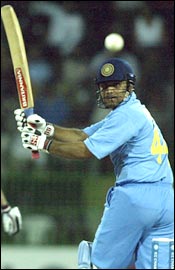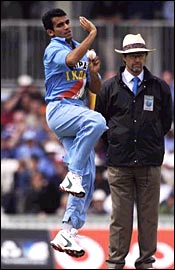Wanted: Horses for courses
Prasanna Desikan
I think he has done an extremely fantastic job so far
and it is important he continues in the same fashion.
The expectations are high since he has done well in a
rather special manner, so all I can say is we should
let him relax rather than put pressure on him," Sachin
noted of Sehwag.
 Sometimes it makes me wonder if these
are pure words of wisdom or a 29-year-old 'veteran'
hoping his colleague doesn't have to go through the
same burden and pressure as himself. I would bet on
the former.
Sometimes it makes me wonder if these
are pure words of wisdom or a 29-year-old 'veteran'
hoping his colleague doesn't have to go through the
same burden and pressure as himself. I would bet on
the former.
The greatest gift of Sehwag is the "shade of
similarities" in his batting style to that of Sachin.
His natural gift of striking the ball will now always
be compared to that of Sachin. What Sehwag should
really capitalize on, is the other "time-given" gifts.
He will not have the burden of the "one-man team"
Sachin had -- till Dravid and Ganguly relieved that
pressure and started playing match-saving and
match-winning knocks.
Sachin almost always had the
pressure of not getting out and in the process curbed his
natural game. Sehwag can now play his natural game and
continue his onslaught. He doesn't have to bother much
about getting out. He will be followed by Laxman, Dravid, Tendulkar,
Yuvaraj Singh and Mohd. Kaif. All of them pretty much at the peak of
their form. This is a "gift" Sachin didn't have as a youngster. If
Sehwag can make use of this opportunity and play some scintillating
knocks, it would benefit his career and the Indian team immensely.
Much has been talked about Sehwag replacing Sachin as
an opener. The obvious question to be asked is: on an
average will India score more with Sachin as an opener
and Sehwag in the middle or the other way round.
Sehwag says he doesn't look beyond 22 yards, then does
it really make a difference if he bats as an opener or
in the middle? He has his principles clear: if the
ball is to be hit, he will.
Let's now take Sachin as an
opener. If he gets going, there are no questions, he
is undoubtedly destructive and a destroyer of the
opposing bowler's confidence. What if he fails? The
present Indian team seems to do good enough even when
Sachin and Sehwag fail. So that is not a big issue.
And Sachin is one of the most consistent among his
peers. He doesn't have a big string of failures.
Also, Sachin and Ganguly have proved to be the best opening
one-day pair. So, statistically, and logically opening
with Sachin is the better option. The other dimension
of cricket that has been discussed a lot these days is
the "mind-game". The question that arises is what is
more terrifying to the opponent -- Sachin gone, Sehwag
to come or Sehwag gone, Sachin to come?
Maybe, we should not stick to one opening pair. Play both of
them according to the situation. If chasing a "big"
total, it would be a safer bet to rely on Sachin to go
for the kill and score big. It should be noted the
"big total" has been redefined for the batting packed
Indian team. Sachin could also open against an
ordinary bowling attack so that chances of losing his
wicket is not high and he is really productive. The
key is, Sachin's wicket is still precious, and hence
the need to preserve it and use at the most needy times.
The ability to switch these players for the
opening slot will also add a bit of suspense and keep
the opponent guessing on the strategies.
"The true art of batting is achieved between 28-32 and
I think Sachin is just there so look out!," said Allan
Border.
In this media focus on Sachin, people seem to have forgotten two other Indian batsmen who are now
between 28-32: Rahul Dravid and Sachin Ganguly. These
two batsmen are peaking and could well be on the track
of "achieving the true art of batting".
Sachin has always been the media focus, and Ganguly has also
received much of the media attention as the Indian
captain. Dravid, on the other hand, is silently
performing and has played some invaluable knocks. His
knocks don't receive much attention in the media, but
as the English players realized, he played some of the
finest innings of all times in the recent Test series
in England. He has played the perfect supportive roles
in ODIs.
Ganguly, with 19 ODI centuries, has been one of the main match-winners in
the shorter version of the game. The fact that Dravid
can keep the wickets or Ganguly can bowl should be
viewed as an additional skill and not as regular
keeper and a bowler.
Yuvraj Singh has matured and is playing more
consistently these days. Mohd Kaif reminds me of Azhar
in his early days. A thin, modest middle order batsman
lending stability to the team and playing crucial,
timely knocks. Physically, he might not appear to be
very destructive, but plays with a commitment. He is
like what Dean Jones was to Australia or Mahanama to
Sri Lanka -- not a big entertainer, but definitely one
of the most reliable and committed players.
With such a talent-packed batting order, what India
truly lacks is a good keeper and an attacking bowling.
Dravid has been moderately successful as a keeper. But
it must be realized that that is not his forte.
Players often say, "If the team needs me to do it,
then I will... ." I believe there is just half-truth in
the statement. The statement should be read as, "If I
have to be in the team, I have to... ." I am not saying
that is true of Dravid or all other players. But it
does appear in that sense when players take up
whatever is assigned to them without thinking how much
they would really be able to contribute.
What happened to Laxman, who was willing to open for the team's
cause? We almost lost him, till he made a great
comeback. Players should not be forced to take up
additional responsibilities that effect their overall contribution. An
injury to Dravid while keeping could prove disastrous, especially on
South African wickets where he has the best batting record for an
Indian.
Keeping will also make him tired and affect his
contribution with the bat.
Ideally, India should have played Parthiv Patel in the
ICC. He seems to be India's future as far as
wicket-keeping is concerned. It would have given him
right kind of exposure playing international cricket
with all the top teams. He would have learnt to handle pressures, bat
against top-quality bowlers and definitely hone his keeping skills. This
tournament would have been a great learning experience for him. It would
have helped him greatly and India would have had at least one regular
talented wicket-keeper for the World Cup. The earlier and more chances
he gets, the better it will help him. It would relieve the
pressure on Dravid.
 The Indian bowling definitely lacks the bite and
consistency. Zaheer Khan bowls with a great heart and
total commitment, but his bowling itself is not as
dangerous or destructive as McGrath, Akram or other
leading pace bowlers now. But occasionally he does
bowl brilliantly and maybe he will develop into
India's leading pace bowler. Harbhajan is India's most
feared bowler. Nicknamed the "Turbanator", he is
definitely the best bowling weapon, unless he decides
to quit cricket and join as DSP in Punjab police.
The Indian bowling definitely lacks the bite and
consistency. Zaheer Khan bowls with a great heart and
total commitment, but his bowling itself is not as
dangerous or destructive as McGrath, Akram or other
leading pace bowlers now. But occasionally he does
bowl brilliantly and maybe he will develop into
India's leading pace bowler. Harbhajan is India's most
feared bowler. Nicknamed the "Turbanator", he is
definitely the best bowling weapon, unless he decides
to quit cricket and join as DSP in Punjab police.
Kumble's experience and flippers are still very handy.
But apart from these three, the Indian bowling attack
can't be relied upon. Each match we have to hope someone
comes up with a magical bowling performance. As far as
ODIs go, we can still win purely on batting as we have
done in the recent past.
But a good bowling attack is definitely a bonus and a
necessity for Tests. Kumble will also probably not
stick along for a long time. We need to look for
quality bowlers and, more importantly, train them. It
should be an accepted fact that we don't produce
naturally talented pace bowlers like Akhtar, Younis,
Lee et al. But what we can do is train the potential
bowlers to play. Some of the potential pace bowlers
could be sent to South Africa or Australia to train
and rise to the level of competition there.
From the
recently concluded under-19 series in England, it can
be noticed that leading Indian wicket-taker Irfan K.
Pathan had some really impressive bowling figures. He
could be one of India's future pace bowlers. T.K.
Patel was also impressive with his leg-breaks and had
some contributions with the bat too. These are the
kind of people we need to watch for and train. Whether
they actually hone their skills and develop into great
players or forever remain promising like Agarkar with occasional
brilliances can be told only through time.
The underlying point is not that India is now the best
team and favorites to win the World Cup. Definitely
Australia and South Africa would still be the
favorites. But the Indian batting has definitely
become a force to reckon with and is capable of
pulling off some stunning victories. Also, it would be
great if the Indian batting can prove itself on the
pitches of South Africa or Australia against the likes
of McGrath, Akram, Pollock, Donald et al.
The bowling department is where India lacks the bite and could give away all that is achieved
through batting. If the selectors and the team concentrate on improving
the bowling, this young Indian cricket team will remain one of the
best teams for a few years, boosting its chances to win any championship
henceforth.
Editor's note: Rediff believes that like its own editorial staffers, readers too have points of view on the many issues relating to cricket as it is played.
Therefore, Rediff provides in its editorial section space for readers to write in, with their views. The views expressed by the readers are carried as written, in order to preserve the original voice.
However, it needs mentioning that guest columns are opinion pieces, and reflect only the feelings of the individual concerned -- the fact that they are published on Rediff's cricket site does not amount to an endorsement by the editorial staff of the opinions expressed in these columns.
Mail Prasanna Desikan